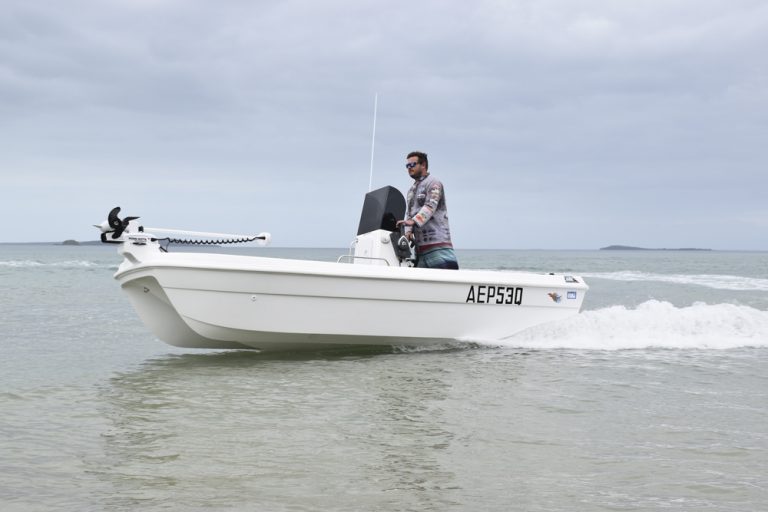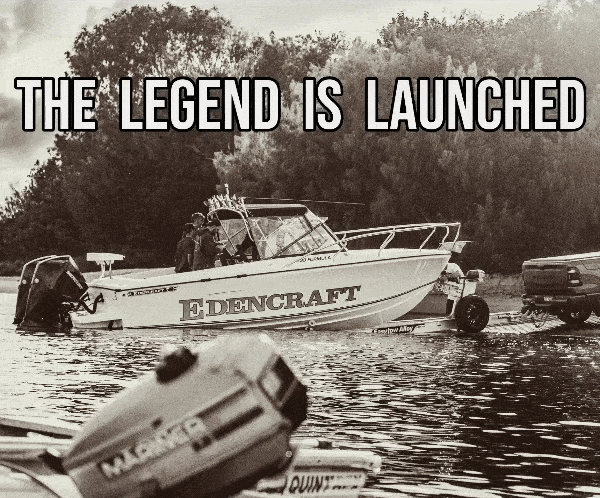Sandy Straits Marine Tri Hull 4.5m Whaler. By Luke Fitzpatrick
Anyone who follows my Fish That Snag fishing and boating adventures on Facebook or through YouTube will know that I absolutely love fishing the flats along the western side of Fraser Island. Sneaking right up into the shallows, sight casting at fish or slowly navigating my way through skinny drains to find a hidden watery hole which holds a fat hungry fish, is, without doubt, my favourite way to fish.
So, when I was presented with an opportunity to test and review a 4.5-metre tri hull made locally by Sandy Straits Marine in Hervey Bay, I became very excited. Add to this, the direction given to me by David Frame, the owner of Sandy Straits Marine. “Luke, just grab the boat over the next few weeks, use it as you would your own boat, try it in all sorts of conditions and give people a fair dinkum, honest opinion of our boat”. It was time to get very excited.
When you first cast your eyes over the 4.5m Tri-Hull, you immediately think, stability, shallow water, flats fishing. And I can, with confidence, tell you that this boat ticks all those boxes and more.
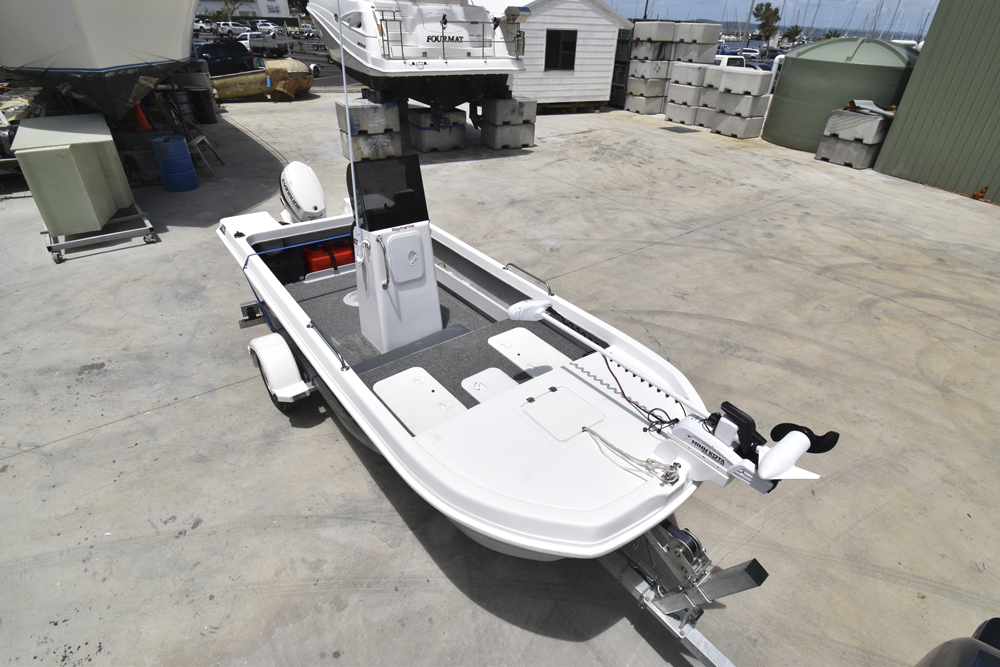
I personally own a 4.4m aluminium tinnie, so I was extremely keen to see how the 4.5m tri hull compared to my own boat. Thus, I am going to present this boat review to you slightly differently than what I usually do. After all, my family and I were gifted with the opportunity to use this boat a few times over an extended period. So, rather than running through copious amounts of tech’s and spec’s (which you can easily find yourself through the Sandy Straits Marine website – http://www.sandystraitsmarine.com.au/) I am instead going to tell you what we achieved while using this boat, and how my family and I rated the 4.5m Tri-Hull, compared to our very own boat.
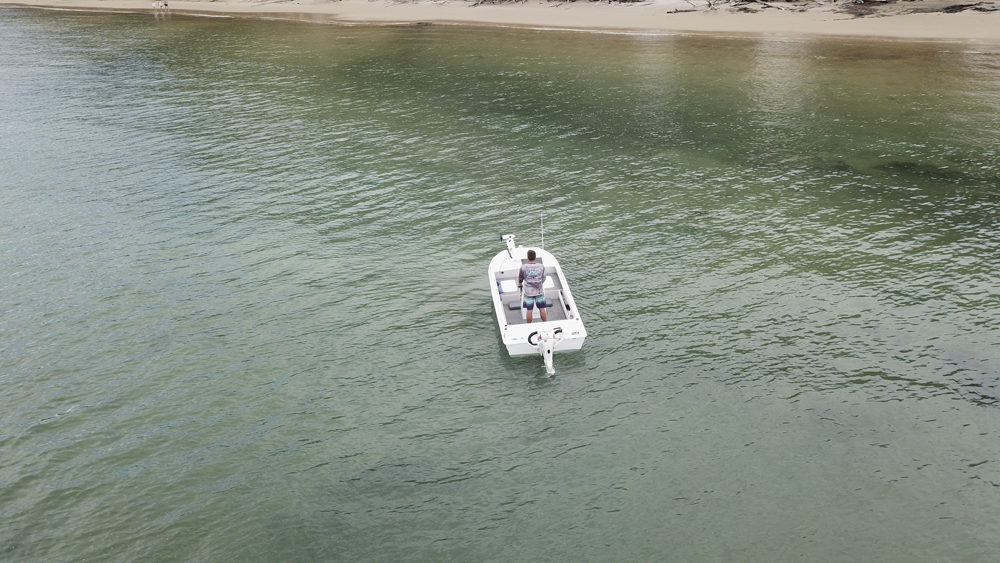
First, the 4.5m Tri-Hull is exceptionally light for a boat of its size, which makes it extremely easy to tow and to launch and retrieve solo. During my time with this boat, I launched and retrieved it at both the Urangan boat ramp in Hervey Bay and at the River Heads boat ramp on the Mary River. I launched and retrieved it using the hand winch, and I also drove the boat on and off the trailer several times without an issue. I even let my eldest son Liam, who is 9, launch and retrieve this boat under supervision, and he had absolutely no trouble.
The secret to the lightweight design of the 4.5m Tri-Hull is that it is a vinyl ester resin-infused hull, this has been laid up with a combination of E glass and Basalt fibre. The transom is made from non-rot material and for added buoyancy, high-density foam has been used under the floor and in the top deck. In total, the boat is a shy over 400kg, matched with a 60hp Evinrude Etec which means you do not need a large 4×4 to tow this boat; instead a mid to large sized sedan would be more than capable.
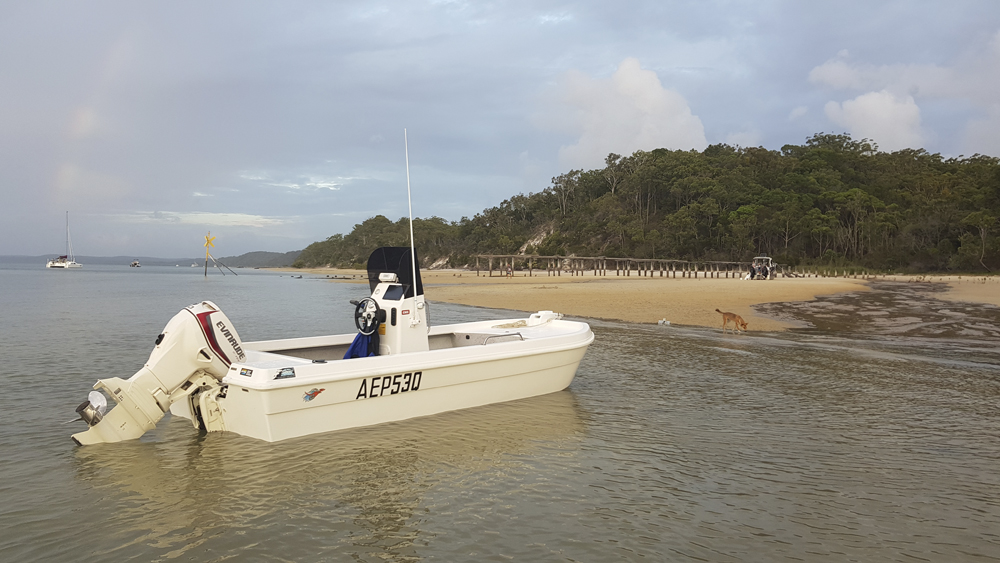
David markets the 4.5m Tri Hull as a bare boat, rated for 4 people and to a max of 60hp. It comes with the floor, and then either as a tiller steer, side or centre console. The rest is up to you and David to discuss during manufacturing.
One limitation I have with my own boat due to its size is the ability to head out on the water when the wind picks up beyond 15-20 knots, especially when trying to navigate the deep-water channels between the mainland and Fraser Island when you have a strong wind blowing against the tide. Don’t get me wrong, our boat is capable, and with a cautious approach, the journey is very achievable, but my lower back hates it due to the jarring you sometimes experience when a lightweight aluminium boat strikes a wave at the wrong angle. Add to this, being in an open boat, the inevitable spray blowing across the boat combines to make it an uncomfortable and at times wet ride.
So, my family was absolutely delighted when I came home with the 4.5m Tri Hull in tow, the wind was gusting around 15 to 20 knots, showers were pushing across Fraser Island, and I insisted that they come and experience how the 4.5m Tri Hull would handle the conditions.
We launched from the River Heads boat ramp and plotted a course for McKenzie’s Jetty on Fraser Island. Upon exiting the heads of the river, we ran straight into strong wind pushing against tide. I trimmed the motor down to lift the bow of the Tri-Hull slightly, eased off the throttle and let the Tri-Hull do its work. The journey is probably best summed up by my son Liam. “It felt kind of like our boat, in the way the boat moved up and down. We did get a little wet due to the rain and wind blowing spray across the boat, but there was no slapping, no jarring. It felt more comfortable, like a cushion when we came down on a wave”.
Of course, we fished the flats of Fraser Island a few times in this boat, and the 4.5m Tri Hull performed extremely well. We were able to push right up into 30cm of water, sneak around under the power of the fitted 55lb MinnKota with iPilot and found the boat extremely easy to manoeuvre in skinny drains. I suspect the fly fishers of the world would be keen to take a closer look at the 4.5m Tri Hull as it does provide great stability for casting.
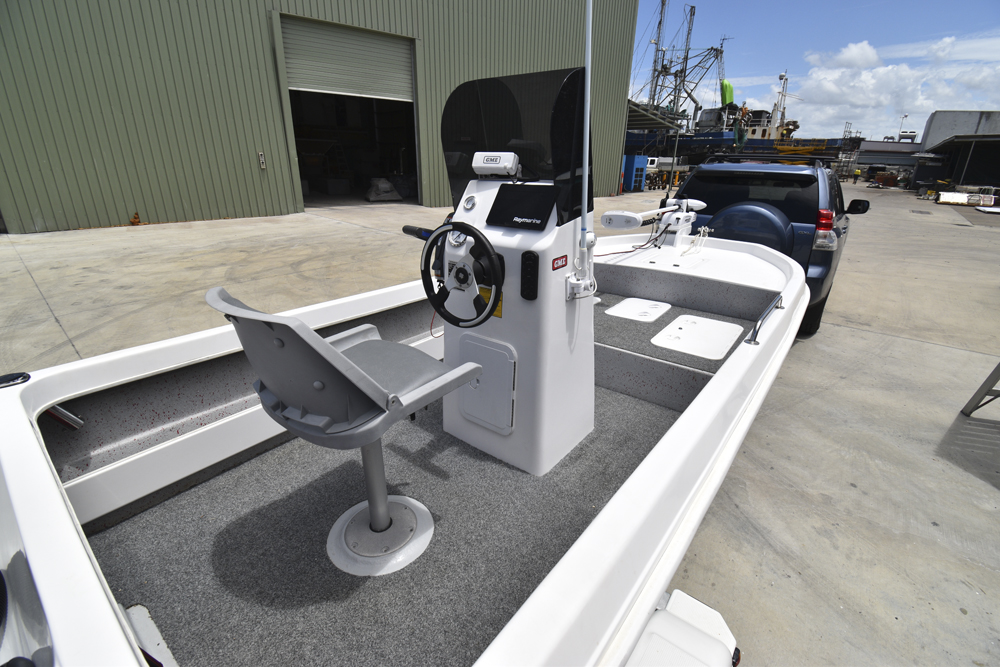
Moving from location to location across the shallow flats was very comfortable and quick with the 60hp Evinrude Etec getting the 4.5m Tri Hull onto the plane very quickly. One thing I did notice, and I suspect it is due to weight distribution, was that I needed to trim the motor right down to stop the boat from porpoising at higher speeds.
My family and I spend a lot of time boating around the Great Sandy Strait, often pulling up into secluded white sandy beaches, allowing the boat to go high and dry, while we explore Fraser Island or simply fish. To achieve this, we need suitable storage space to carry enough food, change of clothes for the boys and of course fishing gear, cast nets, yabby pump etc.
We were able to mostly store in the 4.5m Tri Hull everything we would normally take out on our own boat, but had to make a few compromises due in part I believe to the 4.5m Tri Hull being quite narrow, a shy over 1.6m. This does restrict storage space a little, especially for fishing gear with my greatest challenge being fishing rod storage. With only two flush mounted rod holders in the gunwales, I believe the avid sports fishers out there will be keen on more rod storage being built into the boat.
Of course, being provided with a boat that is so obviously suited for fishing shallow water, I was keen to see how it would perform while fishing in 20m+ of water. But not just how it performed as a fishing platform, but also how easy and comfortable it was for a family of 4 to be on board with a bit of swell around, hooking up to a fish, getting it to the boat and landing it without tripping over each other.
The great news is that we managed to find some decent fish and had no trouble in moving around the boat in the swell, to fight the fish and land them. If a family of four can achieve this on the 4.5m Tri-Hull, then a single fisher or a couple of mates will find it an absolute breeze.
Sandy Straits Marine also build a 7.3m Cat which hopefully we can review for you soon. In the meantime, my final thoughts on the 4.5m Tri Hull.
If you are in the market for a well-suited estuary fishing platform which offers great stability, is innovative in design, extremely cost-effective and is more than capable of being taken out of its comfort zone and can accommodate a family day out on the water, then I encourage you to get into contact with David Frame from Sandy Straits Marine.


